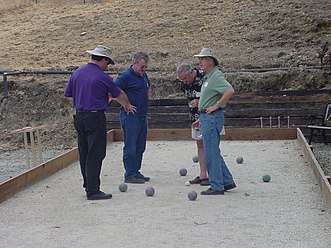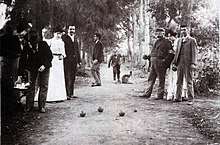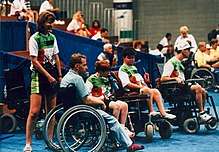Bocce
Bocce (/ˈbɒtʃi/,[1][2] or /ˈbɒtʃeɪ/,[3] Italian: [ˈbɔttʃe]), sometimes anglicized as bocce ball,[4] bocci[5] or boccie,[1] is a ball sport belonging to the boules family, closely related to British bowls and French pétanque, with a common ancestry from ancient games played in the Roman Empire. Developed into its present form in Italy, bocce is played around Europe and also in other areas with Italian immigrants, including Australia, North America, and South America. Initially played only by the Italian immigrants, the game has slowly become more popular with their descendants and more broadly.
 Bocce players scoring a match, 2005 | |
| Highest governing body | Fédération Internationale de Boules |
|---|---|
| Nicknames | Bocci |
| First played | Ancient Rome |
| Characteristics | |
| Contact | Non-contact |
| Team members | Individual |
| Type | Boules |
| Equipment | Bocce (balls) and pallino (jack) |
| Presence | |
| Olympic | No |

History
Bocce is closely related to British bowls and French pétanque, all having developed from games played in the Roman Empire. It was developed into its present form in Italy[6] (where it is called bocce, the plural of the Italian word boccia which means 'bowl' in the sport sense),[7] it is played around Europe and also in regions to which Italians have migrated, such as Australia, North America, and South America (where it is known as bochas, or bolas criollas ('Criollo balls') in Venezuela, bocha in Brazil). The popularity of the game spread first amongst descendants of Italian migrants but has slowly spread into the wider community. The accessibility of bocce to people of all ages and abilities has seen it grow in popularity among Special Olympics programmes globally and it is now the third most played sport among Special Olympics athletes.[8]
Geographical spread
The sport is also very popular on the eastern side of the Adriatic, especially in Croatia, Serbia, Montenegro, and Bosnia and Herzegovina, where the sport is known in Serbo-Croatian as boćanje ('playing boće') or balote (colloquially also bućanje).[9][10][11] In Slovenia the sport is known as balinanje[12] or colloquially 'playing boče', or bale (from Italian bocce and Venetian bałe, meaning 'balls').[13]
Rules and play
Bocce is traditionally played on natural soil and asphalt courts up to 27.5 metres (90 ft) in length and 2.5 to 4 metres (8.2 to 13.1 ft) wide.[14] While the court walls are traditionally made of wood or stone, many social leagues and Special Olympics programs now use inflatable 'Packabocce' PVC courts due to their portability and ease of storage.[15][16] Bocce balls can be made of wood (traditional), metal,[14] baked clay, or various kinds of plastic. Unlike lawn bowls, bocce balls are spherical and have no inbuilt bias.
A game can be conducted between two players, or two teams of two, three, or four. A match is started by a randomly chosen side being given the opportunity to throw a smaller ball, the jack (called a boccino ('little bocce') or pallino ('bullet' or 'little ball') in Italian, depending on local custom), from one end of the court into a zone 5 metres (16 ft) in length, ending 2.5 metres (8.2 ft) from the far end of the court. If the first team misses twice, the other team is awarded the opportunity to place the jack anywhere they choose within the prescribed zone.[6] Casual play is common in reasonably flat areas of parks and yards lacking a Bocce court, but players should agree to the minimum and maximum distance the jack may be thrown before play begins.
The side that first attempted to place the jack is given the opportunity to bowl first. Once the first bowl has taken place, the other side has the opportunity to bowl. From then on, the side which does not have the ball closest to the jack has a chance to bowl, up until one side or the other has used their four balls. At that point, the other side bowls its remaining balls. The object of the game is for a team to get as many of its balls as possible closer to the target ball (jack, boccino, pallino) than the opposing team. The team with the closest ball to the jack is the only team that can score points in any frame. The scoring team receives one point for each of their balls that is closer to the jack than the closest ball of the other team. The length of a game varies by region but is typically from 7 to 13 points.[17][6]
Players are permitted to throw the ball in the air using an underarm action. This is generally used to knock either the jack or another ball away to attain a more favorable position. Tactics can get quite complex when players have sufficient control over the ball to throw or roll it accurately.[6]
Variants
Bocce volo
A variation called bocce volo uses a metal ball, which is thrown overhand (palm down), after a run-up to the throwing line. In that latter respect, it is similar to the French boules game jeu provençal also known as boule lyonnaise. A French variant of the game is called pétanque, and (lacking the run-up) is more similar in some respects to traditional bocce.[18]
Boccia

Another development, for persons with disabilities, is called boccia. It is a shorter-range game, played with leather balls on an indoor, smooth surface. Boccia was first introduced to the Paralympics at the 1984 New York/Stoke Mandeville Summer Games, and is one of the only two Paralympic sports that do not have an Olympic counterpart (the other being goalball).[19]
See also
References
- "Boccie". Collins English Dictionary. HarperCollins. Retrieved 9 July 2019.
- "boccie". Merriam-Webster Dictionary. Retrieved 9 July 2019.
- "bocce". Lexico UK Dictionary. Oxford University Press. Retrieved 9 July 2019.
- E.g.: Brown, Jennifer (2 August 2019). "In Denver, a binge drinking capital, the sober curious movement is gaining popularity". The Colorado Sun. Denver: Civil. Retrieved 7 August 2019.
strangers played bocce ball on a June night
- "bocci". American Heritage Dictionary of the English Language (5th ed.). Houghton Mifflin Harcourt. 2016. Retrieved 7 August 2019 – via TheFreeDictionary.com.
- Malta and Gozo.
- "boccia". Collins Italian–English. Retrieved 8 November 2012 – via CollinsDictionary.com.
- "Special Olympics bocce sport profile". Special Olympics International. Retrieved 12 July 2020.
- "Hrvatski boćarski savez - HBS". hrvatski-bocarski-savez.hr.
- Croatian Bocce Federation
- "BiH Bocce Association". Archived from the original on 29 May 2009. Retrieved 13 March 2012.
- "Bocce Association of Slovenia". Archived from the original on 11 June 2010. Retrieved 16 June 2010.
- "Slovene Ethnographic Museum". Archived from the original on 22 June 2013. Retrieved 13 March 2012.
- "Bocce Volo - Rules - Ch. 1". boccevolo.com.
- Ussery, Peggy. "Bocce ball newest sport for Dothan's Special Olympians". Dothan Eagle. Retrieved 23 July 2020.
- "Oddball Sports - The Best Pop-Up Bocce Settings of All-Time". oddballsports.tv. Retrieved 23 July 2020.
- "Bocce Volo - Rules - Ch. 2". boccevolo.com.
- Petanque vs. Bocce at Petanque America
- "Boccia". Paralympic.org. International Paralympic Committee. Retrieved 12 March 2018.
External links
| Wikimedia Commons has media related to Bocce. |